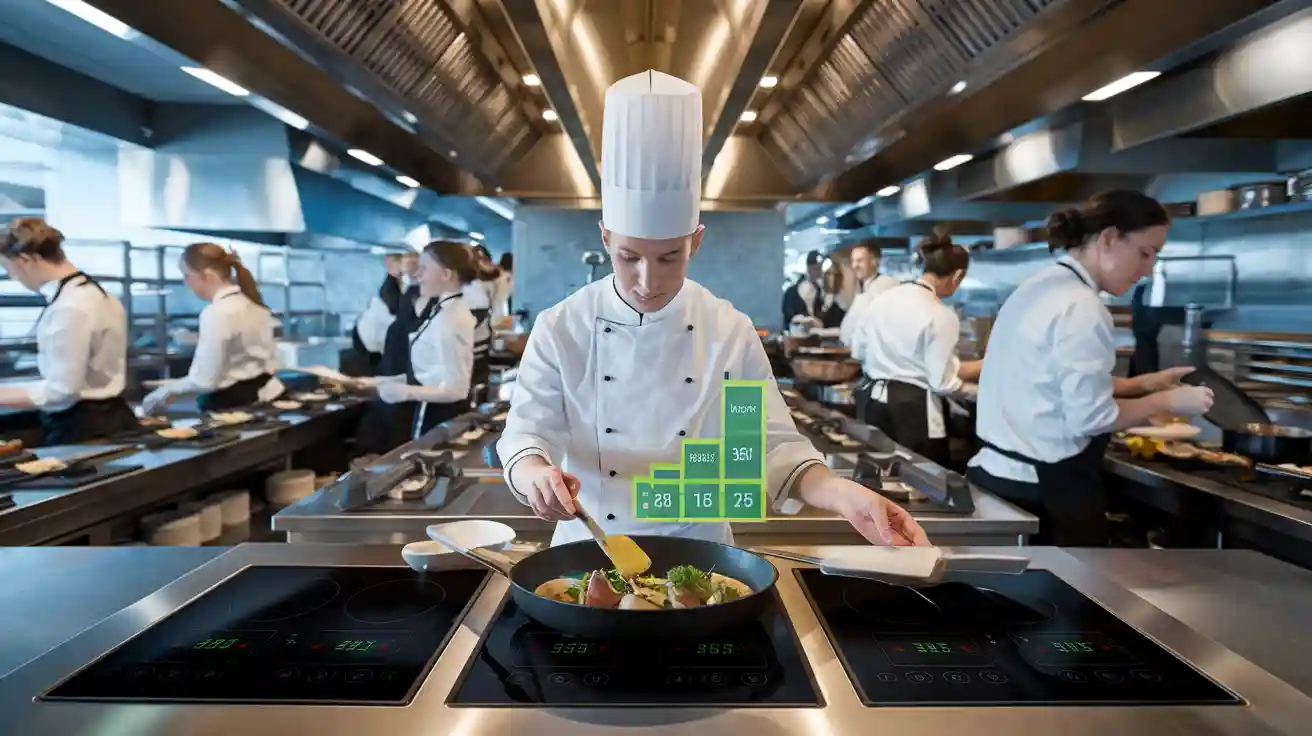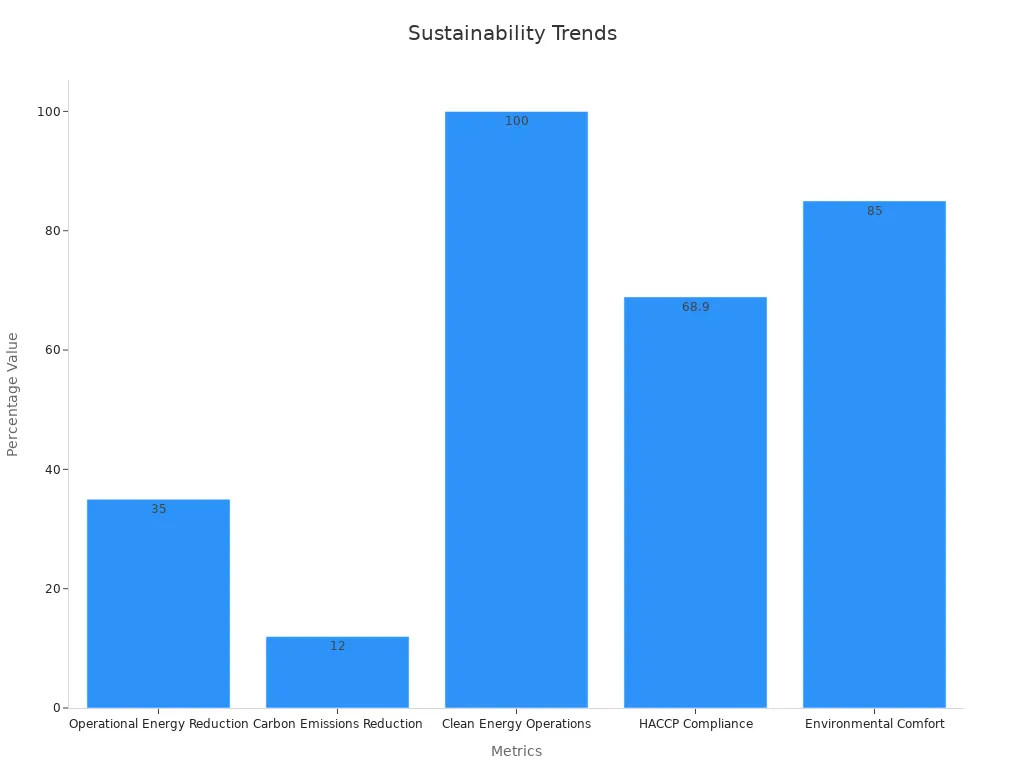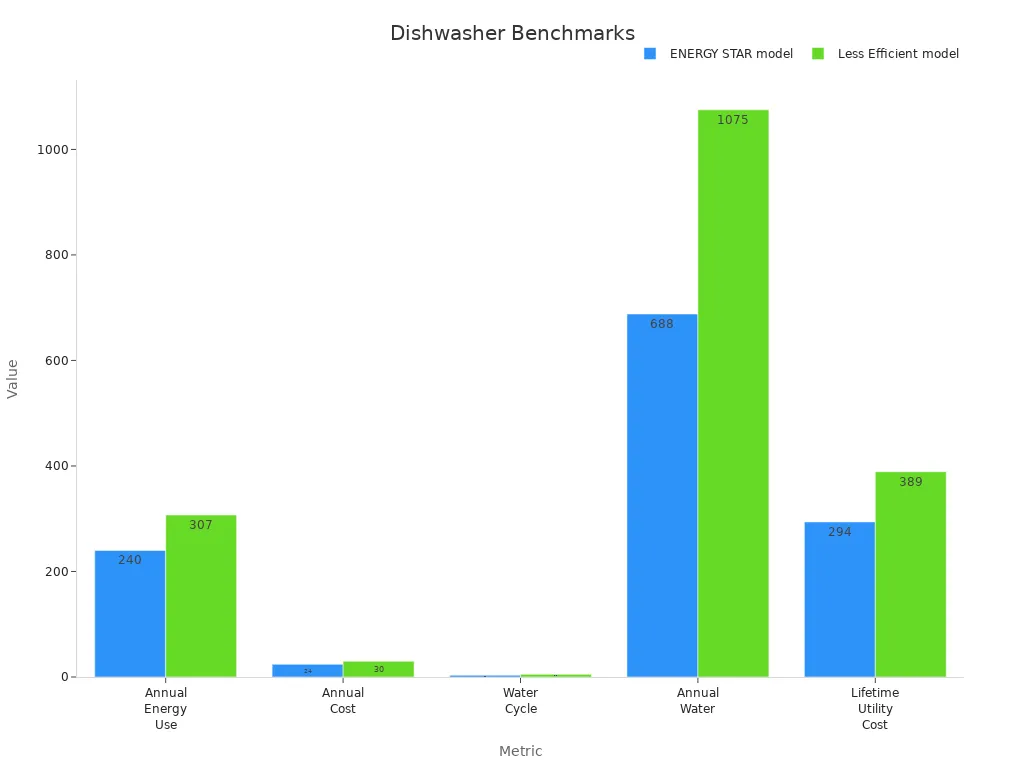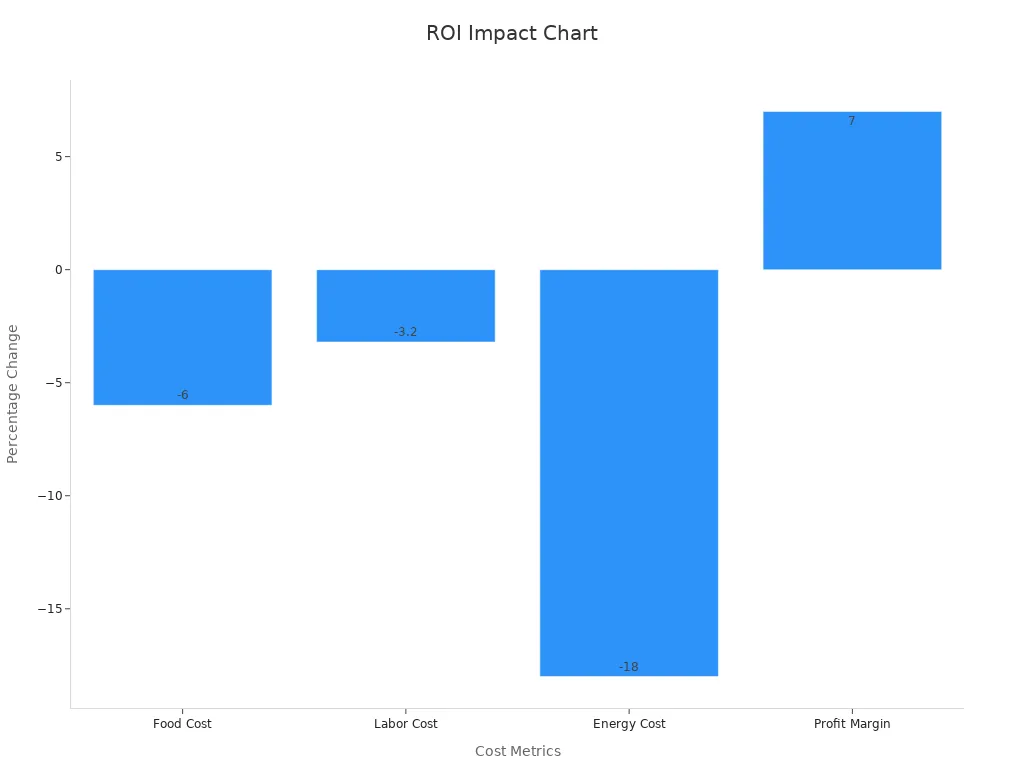
Switching to energy-efficient commercial kitchen cooking equipment gives you fast cost savings and boosts kitchen performance.
- Smart technologies like sensor systems and AI help you cut waste, save water, and improve staff workflow.
Restaurants using these upgrades see better sustainability, fewer breakdowns, and stronger reputations.
Benefits of Energy-Efficient Commercial Kitchen Cooking Equipment
Lower Energy Bills and Operating Costs
You can lower your restaurant’s energy bills by upgrading to energy-efficient commercial kitchen cooking equipment. These appliances use less electricity and water, which means you spend less money each month. Many ENERGY STAR-certified models cut energy use by 10% to 70% compared to standard equipment. This includes refrigerators, ovens, fryers, steamers, and dishwashers.
- Induction cooktops heat up quickly and use precise controls, so you waste less energy.
- High-efficiency refrigerators use better insulation, LED lights, and smart compressors to save power.
- Special dishwashers use less water and heat, which lowers both water and energy bills.
- Many states and utilities offer rebates of $500 to $1,000 when you buy energy-saving equipment.
Tip: Regular maintenance, like fixing refrigerator gaskets and recalibrating thermostats, helps keep your equipment running efficiently and saves even more money.
Reduced Maintenance and Extended Equipment Lifespan
When you invest in energy-efficient commercial kitchen cooking equipment, you get appliances built with stronger materials and advanced technology. These machines last longer and break down less often. You will spend less time and money on repairs and replacements.
Energy-efficient appliances often come with longer warranties. This gives you peace of mind and protects you from surprise costs. Over time, your kitchen runs smoother, and you avoid the hassle of frequent breakdowns.
Improved Kitchen Workflow and Staff Comfort
Modern energy-efficient equipment makes your kitchen a better place to work. High-efficiency ovens and griddles cook food faster and more evenly. This helps your staff finish orders quickly and keeps customers happy.
- Better ventilation systems improve airflow and control kitchen temperatures.
- ENERGY STAR dishwashers and refrigerators save energy without losing performance.
- Smart kitchen layouts, supported by efficient equipment, reduce bottlenecks and make it easier for staff to move around.
- Improved teamwork and higher morale come from clear roles and less stress.
Note: Upgrading your equipment can also reduce heat and odors, making the kitchen more comfortable for everyone.
Enhanced Sustainability and Brand Reputation
Energy-efficient commercial kitchen cooking equipment helps your restaurant use less energy and water. This lowers your carbon footprint and supports a cleaner environment. Customers notice when you care about sustainability, and many prefer to support eco-friendly businesses.
| Metric | Value | Description |
|---|---|---|
| Energy Savings | 21 million kWh | Saved by a pizza chain of 300 restaurants (2017-2022) |
| Operational Energy Reduction | Up to 35% | Reduction through automation and AI-based management |
| Carbon Emissions Reduction | 12% | Sweetgreen’s reduction from 2019 to 2022 |
| Clean Energy Operations | 100% | Sweetgreen’s achievement of fully clean energy in operations |
| Environmental Comfort | Above 85% | Customer comfort level ensured by energy management systems |

- Using less energy and water saves money and helps the planet.
- Sustainable practices, like reducing food waste and using green packaging, lower costs.
- Customers trust and return to brands that show real commitment to the environment.
Callout: Regular energy audits and smart meters help you track your progress and keep improving your sustainability efforts.
High-Impact Commercial Kitchen Cooking Equipment Upgrades

Induction Cooktops and Combi Ovens
You can boost your kitchen’s efficiency by upgrading to induction cooktops and combi ovens. Induction cooktops use up to 70% less energy than traditional cooking methods. They heat up fast and give you better temperature control, which means less wasted energy and faster cooking times. Combi ovens combine steam, convection, and microwave technologies. This lets you cook many types of food with one appliance and saves space.
| Appliance Type | Efficiency & Energy Savings | Additional Benefits & Notes |
|---|---|---|
| Induction Cooktops | Use up to 70% less energy than traditional cooking methods. | Faster cooking, less heat loss, easier cleaning, better temperature control |
| Combi Ovens | Reduce overall energy consumption with multiple cooking modes | Precise controls, replaces several appliances, saves space |
Tip: You may qualify for rebates or credits when you switch to these energy-saving appliances.
High-Efficiency Fryers and Steamers
High-efficiency fryers and steamers can transform your kitchen’s performance. These devices increase thermal efficiency by 40% compared to older models. You will save money on energy bills and use less oil. Oil in high-efficiency fryers lasts 30% longer, so you replace it less often. Industry experts predict that most new restaurants will use induction fryers soon because they save energy and improve food quality.
- Faster cooking times
- Lower energy costs
- Better food consistency
ENERGY STAR Refrigeration and Dishwashers
ENERGY STAR-rated refrigeration and dishwashers help you cut costs and save resources. These models use less electricity and water than standard equipment. For example, ENERGY STAR commercial dishwashers save about 2,400 kWh and $360 each year. Over their lifetime, you can save more than $3,290. They also use 50% less water per cycle.

Note: Lower energy and water use means you help the environment and save money at the same time.
Multi-Function and Smart Cooking Appliances
Smart commercial kitchen cooking equipment brings automation and data to your kitchen. Smart ovens and robotic fryers automate cooking, which saves time and reduces mistakes. Voice controls let you manage several devices at once. These appliances track energy use and send alerts for maintenance, so you avoid costly repairs. Real-time monitoring helps you keep food safe and meet health standards.
- Automated cooking improves speed and consistency
- Predictive maintenance reduces downtime
- Data insights help you make better decisions
| Case Study / Example | Description | Impact |
|---|---|---|
| High-volume QSR smart kitchen integration | Smart ovens, refrigerators, and dishwashers controlled remotely; automated inventory system | Improved efficiency, less waste, better product consistency |
| Eco-conscious restaurant kitchen | Energy-efficient induction cooktops, high-efficiency refrigeration | Reduced environmental footprint, strong operational efficiency |
Callout: Upgrading your commercial kitchen cooking equipment can lead to higher guest satisfaction and more repeat customers.
Steps to Upgrade and Maximize Efficiency
Evaluate Current Commercial Kitchen Cooking Equipment
Start by checking the condition and performance of your kitchen appliances. Use these steps to guide your evaluation:
- Check the age of each appliance. Ovens last about 15-20 years, walk-in coolers over 15 years, and deep fryers up to 20 years.
- Track how often you repair each item. If repairs happen more often or performance drops, it may be time to replace.
- Review warranty coverage and compare the cost of repairs to the price of new equipment.
- Think about your kitchen layout. Upgrading can improve workflow and energy use.
- Choose repair companies with trained technicians and good access to parts.
- When replacing, compare new and used options. Always look for energy efficiency to lower costs.
You can also use these metrics to help decide:
| Evaluation Metric | Description |
|---|---|
| Energy Consumption | Measure actual energy use and compare to industry standards. |
| Maintenance Records | Check for frequent repairs or major issues. |
| Cost Analysis | Look at life cycle costs and possible savings from upgrades. |
| Health and Safety Compliance | Make sure equipment meets safety and sanitation rules. |
Train Staff for Efficient Equipment Use
Training your team helps you get the most from your new appliances. Well-trained staff work faster and safer. They also use equipment settings correctly, which saves energy and keeps food quality high.
| Outcome Measured | Description |
|---|---|
| Enhanced Time Management | Staff learn to use machines like combi ovens to speed up service. |
| Advanced Equipment Utilization Techniques | Training teaches better planning and reduces wait times. |
| Increased Productivity | Skilled staff complete tasks more efficiently. |
| Quality Food Production Techniques | Proper use of settings ensures great food every time. |
| Compliance with Legal and Industry Standards | Training covers food safety and legal rules. |
| Hands-On Training Value | Practice with real equipment builds confidence. |
| Safety and Equipment-Specific Knowledge | Staff learn safety steps and how to avoid mistakes. |
| Adaptive Learning and Train-the-Trainer Programs | Training adapts to your kitchen’s needs and keeps skills fresh. |
Tip: Ongoing training keeps your team up to date as you add new technology.
Leverage Rebates, Incentives, and Financing Options
You can save money by using rebates, tax credits, and grants when you upgrade. Many utility companies and government programs offer instant discounts for energy-efficient appliances.
| Financial Incentive Type | Description | Example Amounts / Details |
|---|---|---|
| Rebates | Discounts from utilities for ENERGY STAR appliances | $105–$4,000 on ovens; $100–$2,075 on fryers |
| Tax Credits | Federal and state tax breaks for eco-friendly equipment | Varies by location |
| Grants | Government and non-profit support for sustainable upgrades | Amounts vary |
| Manufacturer Discounts | Lower prices on green models | Varies |
| Low-Interest Financing | Special loans for energy upgrades | Terms vary |
Note: Some rebates depend on your income or the type of appliance you buy.
Implement Smart Habits and Regular Maintenance
Good habits and regular care keep your kitchen running smoothly and save energy. Poorly maintained equipment can use up to 30% more energy. Clean refrigerator coils every three months to prevent compressor problems. Remove grease from ovens and ranges to cut energy waste. Service fryers and dishwashers often to lower water and energy use. Replace air filters and check HVAC systems to keep bills down.
- Cleaning and maintenance extend equipment life by 2-3 years.
- Proactive checks can reduce downtime by up to 20%.
- Well-kept appliances use less energy and cost less to run.
- Documented maintenance can increase resale value by up to 25%.
Callout: Set daily, weekly, and monthly schedules for cleaning and inspections to avoid costly repairs and keep your kitchen efficient.
You can transform your restaurant by upgrading to energy-efficient commercial kitchen cooking equipment. These upgrades cut energy use by up to 50% and boost performance.
| Metric/Equipment Type | Energy Savings / Efficiency Benefit |
|---|---|
| General energy savings | 20% to 50% reduction by using energy-efficient equipment |
| Refrigeration/Freezers | 20% more efficient (Energy Star certified) |
| Dishmachines | 40% more efficient (Energy Star certified) |
| Ovens | 20% more efficient (Energy Star certified) |
| LED Lighting | Consumes up to 90% less power than incandescent bulbs |

Smart investments today help you lower costs, improve quality, and secure your place in a competitive market.
FAQ
What is the best way to start upgrading your kitchen equipment?
You should begin by checking your current appliances. Look for ENERGY STAR labels when you shop for new equipment.
Tip: Make a list of your oldest or least efficient machines first.
How much money can you save with energy-efficient equipment?
You can save up to 50% on energy bills. The exact amount depends on your equipment and how you use it.
- ENERGY STAR appliances often pay for themselves within a few years.
Do energy-efficient appliances need special maintenance?
No, you can follow the same cleaning and care steps. Regular maintenance helps all equipment last longer and work better.
Note: Always read the manufacturer’s guide for best results.


